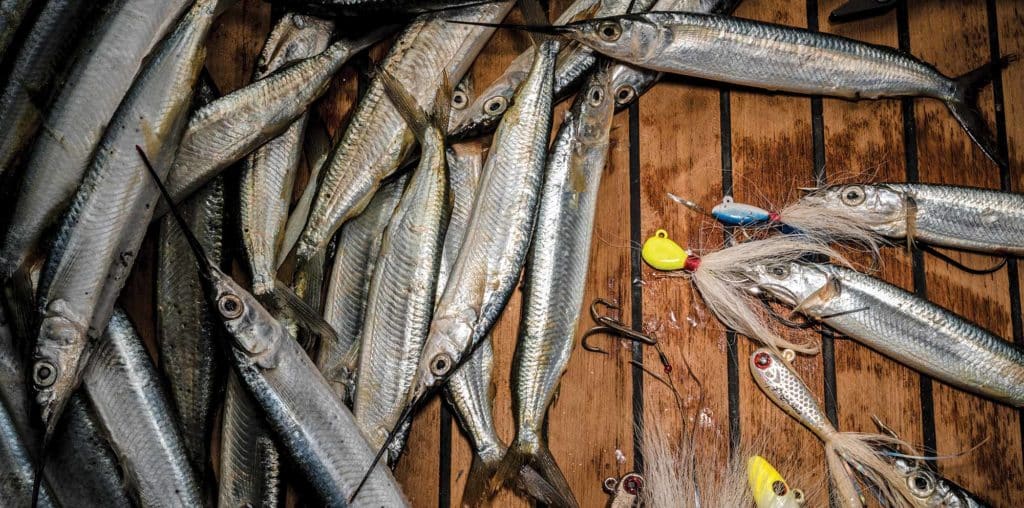
Carefully, I laid a ballyhoo next to an R&R Tackle bucktail jig with two chained, long-shank 7/0 VMC hooks coming off the jig hook, to judge where each hook should be placed into the bait. I broke off the ballyhoo’s beak, then first inserted the last hook point into the ballyhoo’s belly just ahead of the pelvic fin; the middle hook went in just behind the bait’s throat area; and I sunk the first hook (the jig hook) into its chin and out its head just in front of the eyes.
Then, from the stern of a 32-foot Yellowfin, on that early-winter morning off Key Largo, I cast out the bait-and-lure as far as I could in the direction the boat was drifting. The ballyhoo began “swimming” downward as I let the 30-pound braid slip from my fingers, ready to flip the bail shut in a hurry. I knew that if a big kingfish intercepted the rig, I’d have only a second as line shot from my spool to get the hooks set before the toothy jaws would somehow manage to leave me with half a ’hoo, despite all the hooks embedded in the baitfish.
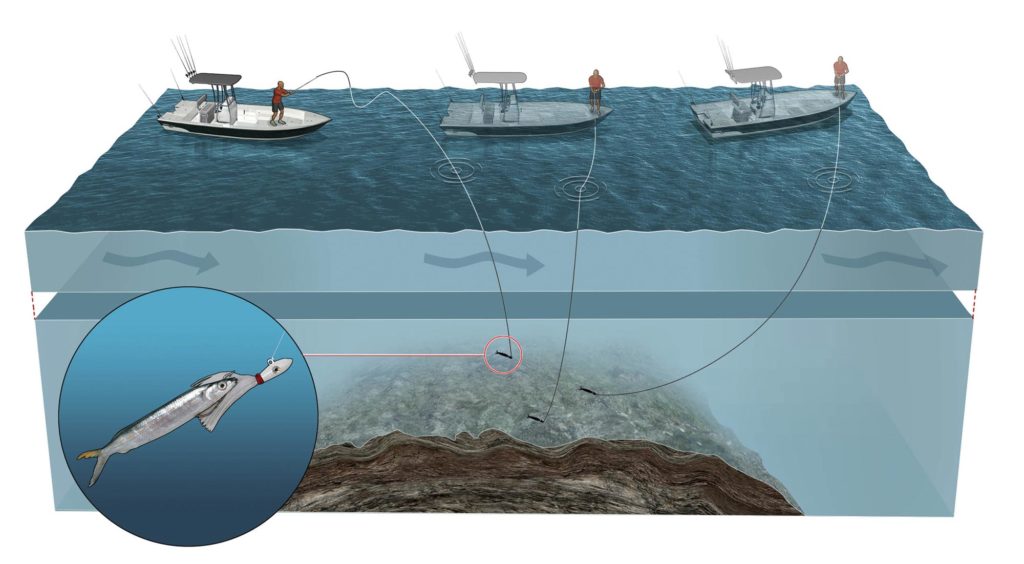
By the time our drift had put us roughly over where I’d cast the ’hoo, my line was nearly vertical, and the light jig had to be nearing the bottom, 240 feet down. With the bail open, I periodically lifted the rod tip to feed line, keeping a belly of slack to allow the jig to sink freely. Each time the line started to come tight, I repeated the process until I saw that the belly in the line from lifting the rod tip remained longer than it had. That told me the jig had come to rest on the reef.
Quickly, before the jig could find purchase in the structure, I flipped the bail and began lifting the rod in long, slow, high sweeps, slowly reeling down after each. I did this several more times, then opened the bail to let the jig fall again.
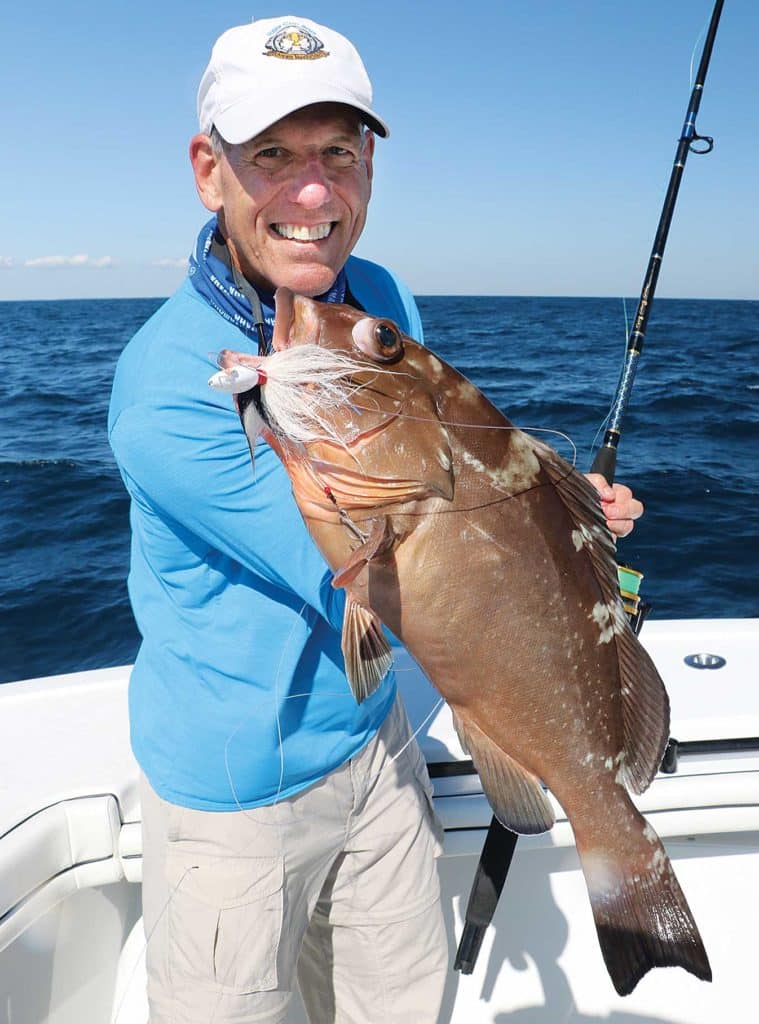
I would repeat that entire sequence — slowly jigging up the ballyhoo in four or five sweeps of the rod — until the bait was far behind in the current, and the line angle was perhaps 45 degrees. Then I would keep up that jigging motion until something inhaled the ballyhoo or it was back at the boat. If the rig looked to still be in good shape, I’d recast and start the process again.
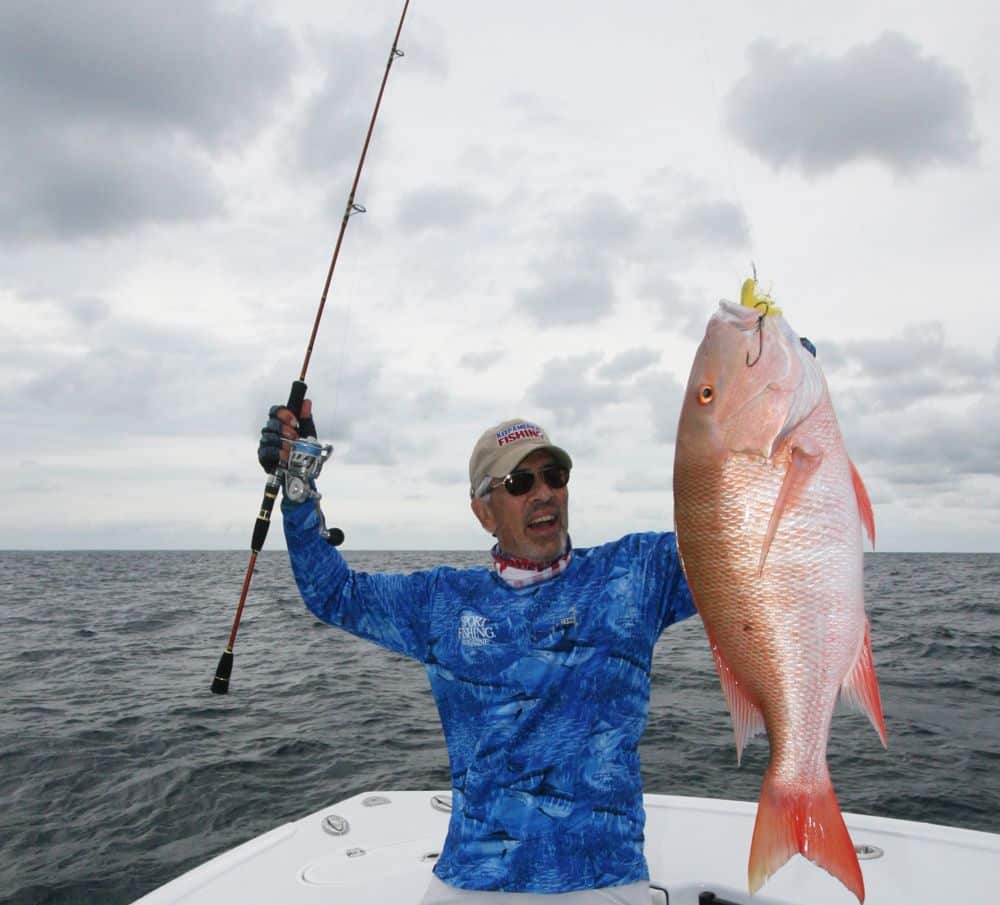
A Screaming Run
But in this instance, I didn’t get to retrieve the jig. Instead, after one of the sequences of jigging the lure upward several times, just as I was letting it drift down again, something snatched up the bait in a screaming run. I flipped the bait, and instantly my rod was bucking, line sizzling off the Shimano Stella.
I found myself feathering the spinner’s spool, with the fish’s downward trajectory taking it toward the reef. Fortunately, the fish had struck well up above the coral, giving me a cushion to work with.
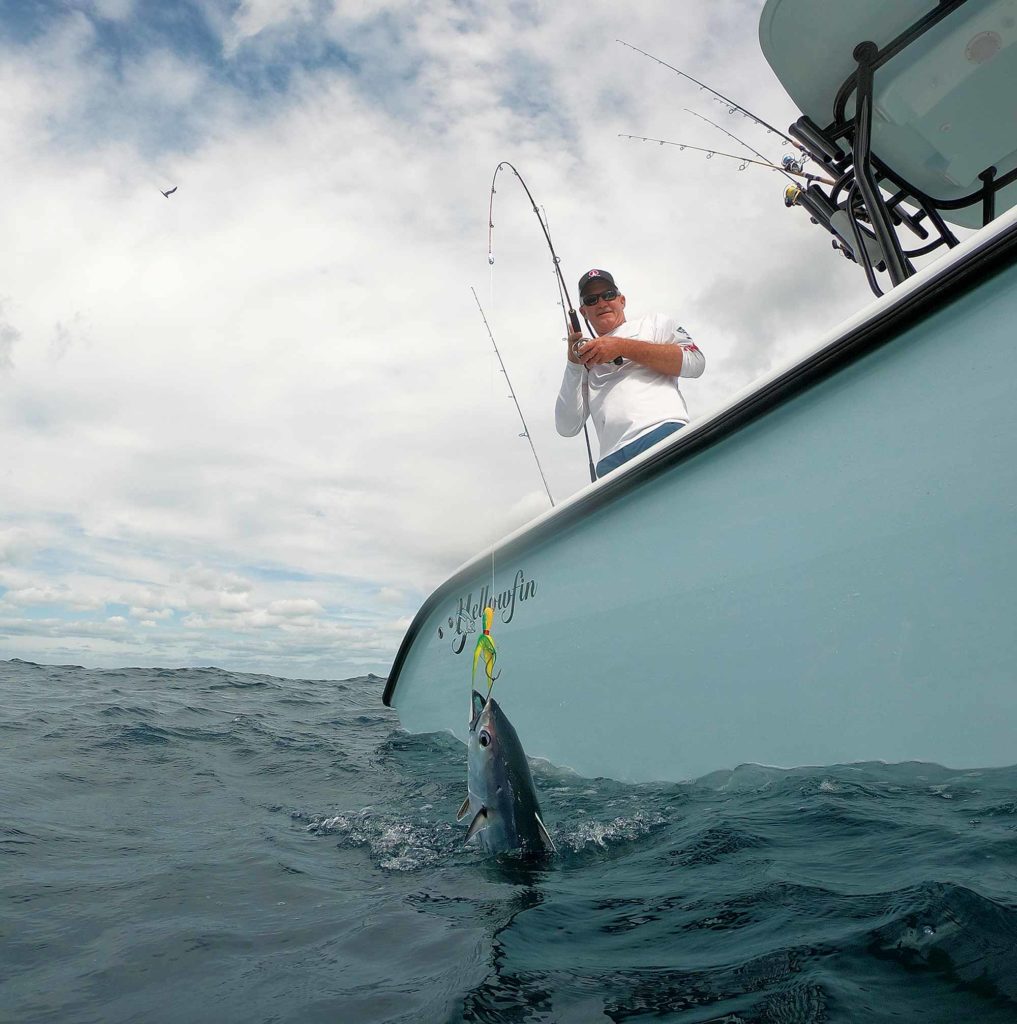
And work I did — straining for all my tackle and I were worth to slow the brute. As I fought the fish, speculation ran rampant, with the various guesses as to what I had hooked, including amberjack, mutton snapper and barracuda.
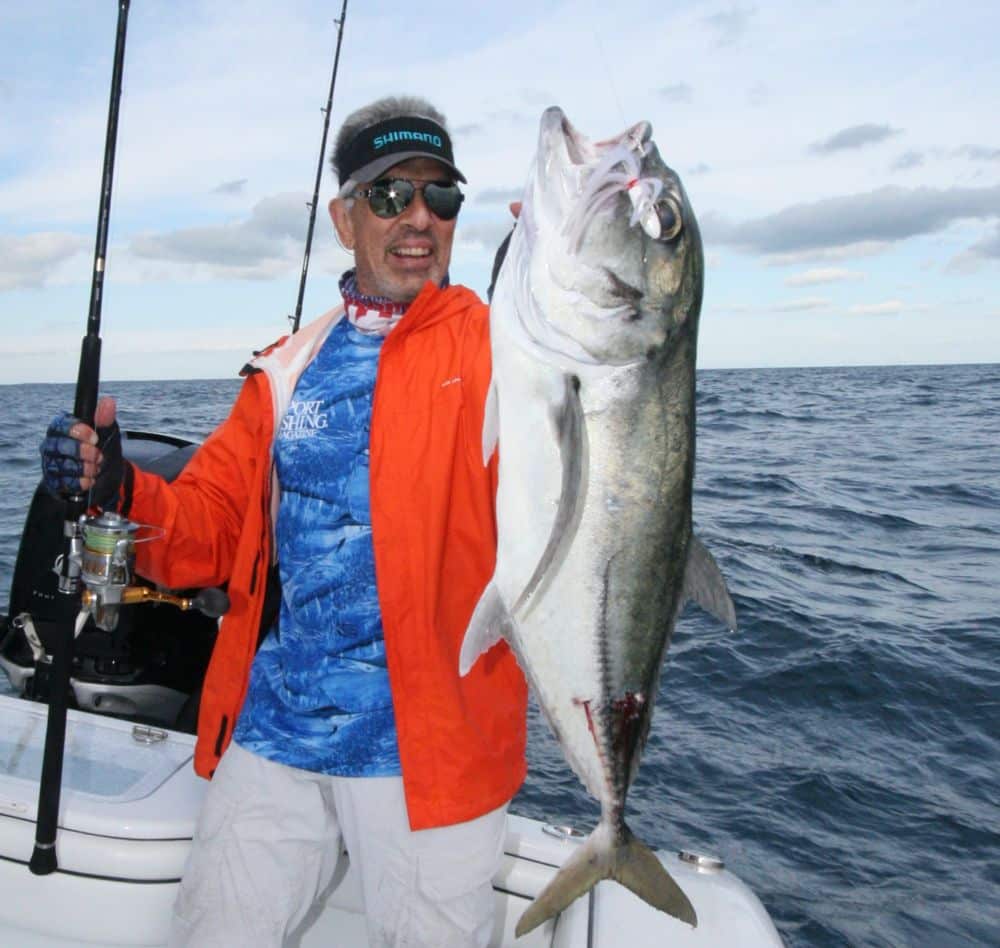
But when my prize finally reached the boat, we saw I had hooked a real horse of a horse-eye jack. No member of the family of jacks and trevallies (Carangidae) fights any harder than the tough horse-eye, so I wasn’t surprised that we’d expected to see an even larger fish.
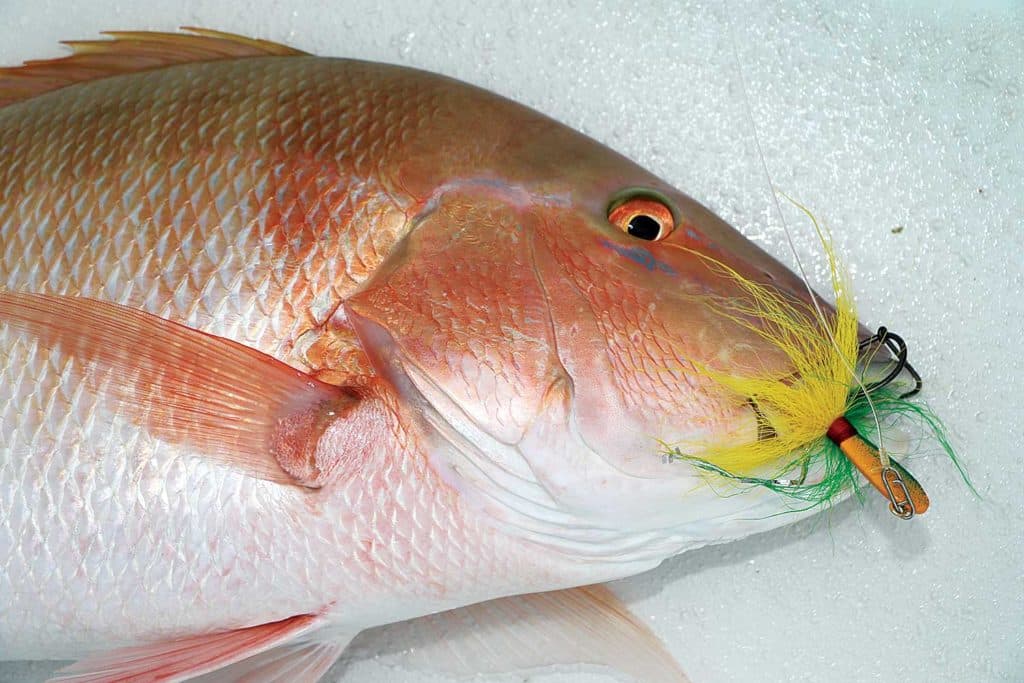
I added that horse-eye to the list of species I had landed that morning (we won’t dwell on others that were lost between hookup and release) — among them kingfish, mutton snapper, skipjack, barracuda (one that jumped as high as a tarpon would) and a big scrawled filefish — all on bucktail-jig-and-ballyhoo rigs.
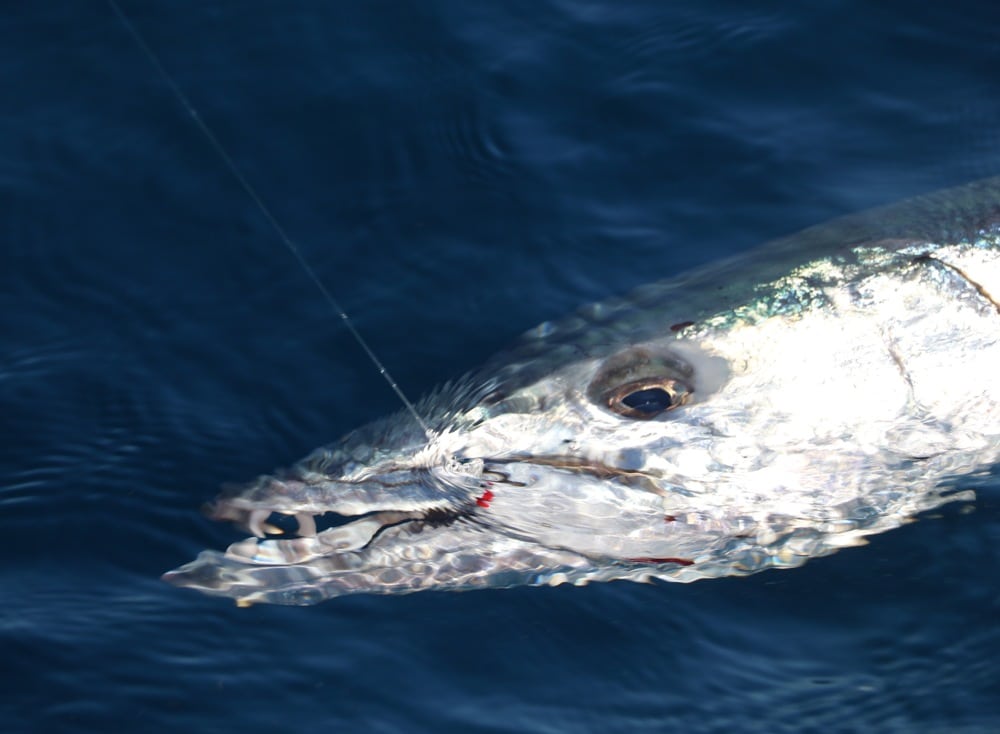
Lost Art
Rewind a few decades. Things were a bit different when I was growing up in Miami. For one thing — sure, we enjoyed somewhat easier fishing thanks to more fish and fewer anglers. I fished bucktails not at the stern of a center console but from the pulpit of a party boat. And my spinning gear was a bit bigger and clunkier than the reels of 2018. Also, notably, braided fishing lines didn’t exist, so we fished mono.
But the bucktail jigs armed with chained hooks and ballyhoo, and the tactics for fishing these rigs over moderately deep reefs, were identical now as then.
Recently, during a tackle-organizing session in my garage, I came across a Plano box full of bucktail jigs, and I realized how long it had been since I had fished them with ballyhoo over the reefs. And I’d never done so with braid (versus mono).
In fact, it occurred to me that casting bucktails and ballyhoo has become something of a lost art for many younger anglers.
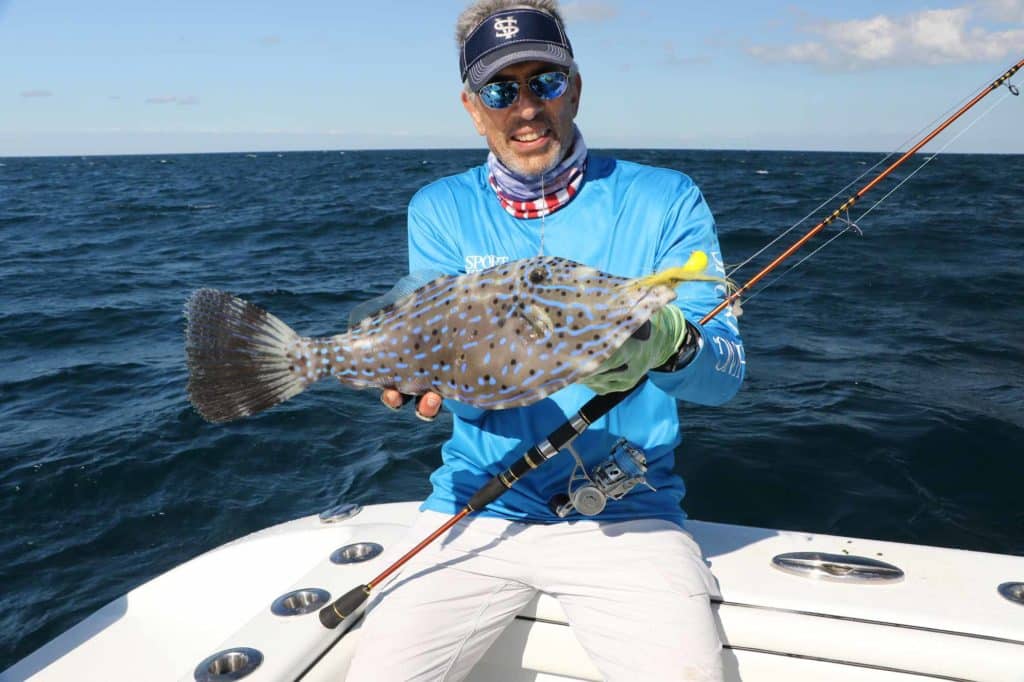
Thus it was that I found myself off Key Largo on the Yellowfin belonging to Sport Fishing‘s Scott Salyers, along with his pal Bobby Brown, also from Miami and acting as guide (a man with the numbers!) here; Rich Weinstein of Key Largo’s Ocean Reef Club; and, making a special guest appearance one day, Miami’s renowned Capt. Jimbo Thomas.
While fishing proved tough overall, it became clear that the technique could still work its magic.
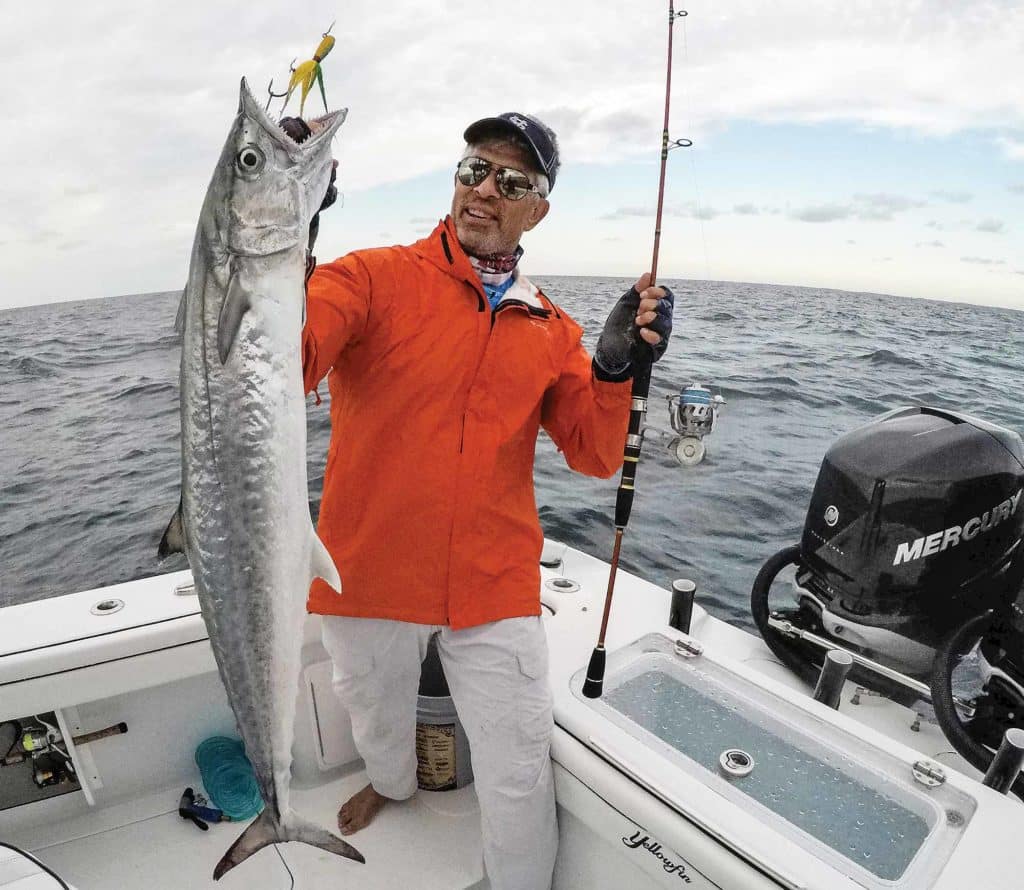
Top-to-Bottom Weapon
This isn’t to say this method will necessarily out-fish others. In part, its relegation to largely forgotten status has to do with the increasing use of live bait in recent decades. And live bait is, of course, always hard to beat.
But keeping some chain-hooked bucktails in one’s tackle box to fish with ballyhoo can offer another good option, another weapon in the reef-angler’s arsenal.
And the technique has some particular advantages. One of my favorites is the angler’s ability to effectively fish the entire water column each cast. Once the jig hits the water, it’s fishing. Lighter jig heads provide a much slower sink rate than is the case when bait is dropped using heavy sinkers. That slower downward drift makes the ballyhoo resemble wounded or dying prey. I’ve caught or seen caught wahoo and sailfish this way, and it’s assuredly a great way to get kingfish strikes, as well as action from blackfin and little tunny.
If no predator sees the drifting bait early on, as it begins to fall deeper, jacks, snapper, grouper and other reef-loving species can spot the bait when it is well over their heads; they’ll often swim up 20 or 30 feet to snatch it. That gives the angler an advantage of time to turn the fish before it can make the coral.
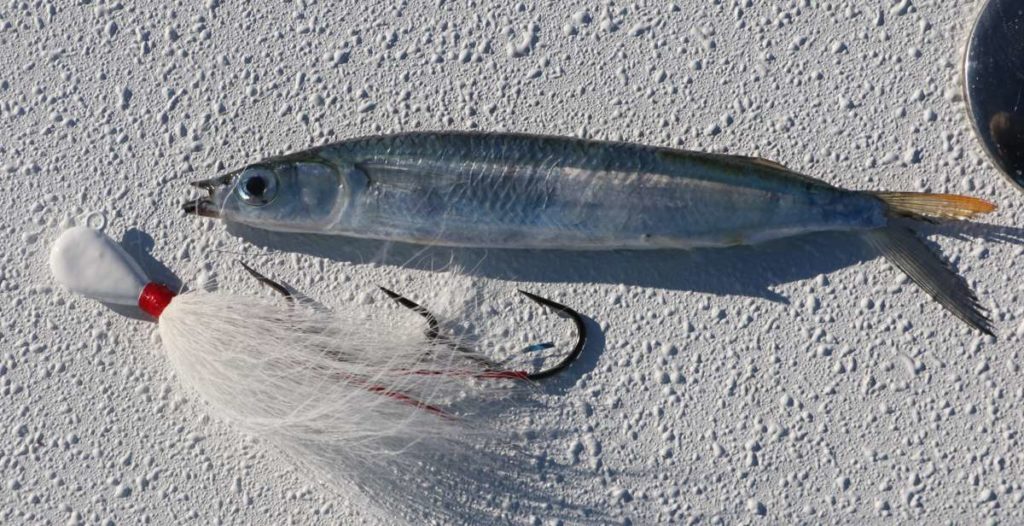
Tips on Tackle
The gear required to fish ballyhoo on bucktails is fairly simple, starting with bucktails themselves. Despite the rather generic “bucktail” term, any lead-head with natural or artificial hair can work fine, certainly including those with sleek nylon fibers. Either way, the Upperman-style head is pretty classic in this use.
We fished both Upperman- and pilchard-style jigs from R&R Tackle, which offers high-quality jigs at reasonable prices. R&R also offers heavier jigs, up to 6 ounces.
While some anglers might be tempted to put a ’hoo on a 4- to 6-ounce jig, feeling that they’re “wasting time” with the slow fall of lighter jigs, my experience says otherwise. Sure, heavy jigs will work, but much less effectively. I suspect that has to do with less action using the heavier lead. Fish seem to find the bait more slowly fluttering down at first drop or between jig sweeps of the rod more tempting.
As a rule, lighter jigs will spark the most action. Of course, rate of current drift and wind drift as well as depth of water are all factors in deciding jig weight. But when fishing my preferred depth (100 to 200 feet) in light to moderate current, I’ll stick with ¾- to 1½-ounce jigs, 2 ounces maximum.
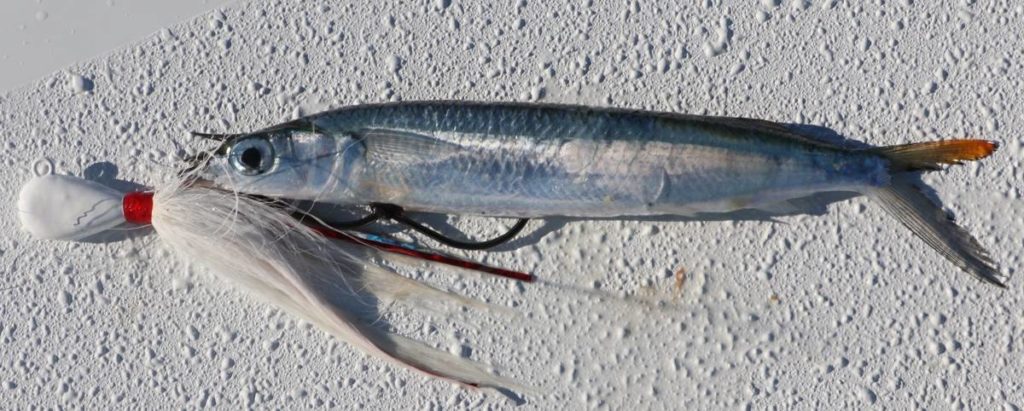
To chain another hook or hooks onto the bucktail, you’ll need a pair of Manley pliers or similar (see photo, below). These have narrow side cutters that allow you to insert them as if trying to “cut” the crack in the hook eye to squeeze that crack a bit wider — enough to insert a hook through the eye. Then simply squeezing the eye shut again creates a chained hook.
For this use, I prefer VMC 9255 O’Shaughnessy Closed Eye (long shank) and/or VMC 7265 O’Shaughnessy Live Bait (short shank) hooks, though Eagle Claw and other manufacturers offer hooks that will work. (Beware of models with eyes too large or your hooks will simply slip out; too small, and you won’t be able to squeeze the eye fully shut around the chained hook.)
The number of hooks you opt for will vary by size of the ballyhoo and also whether you want long or short shanks, or some combination.
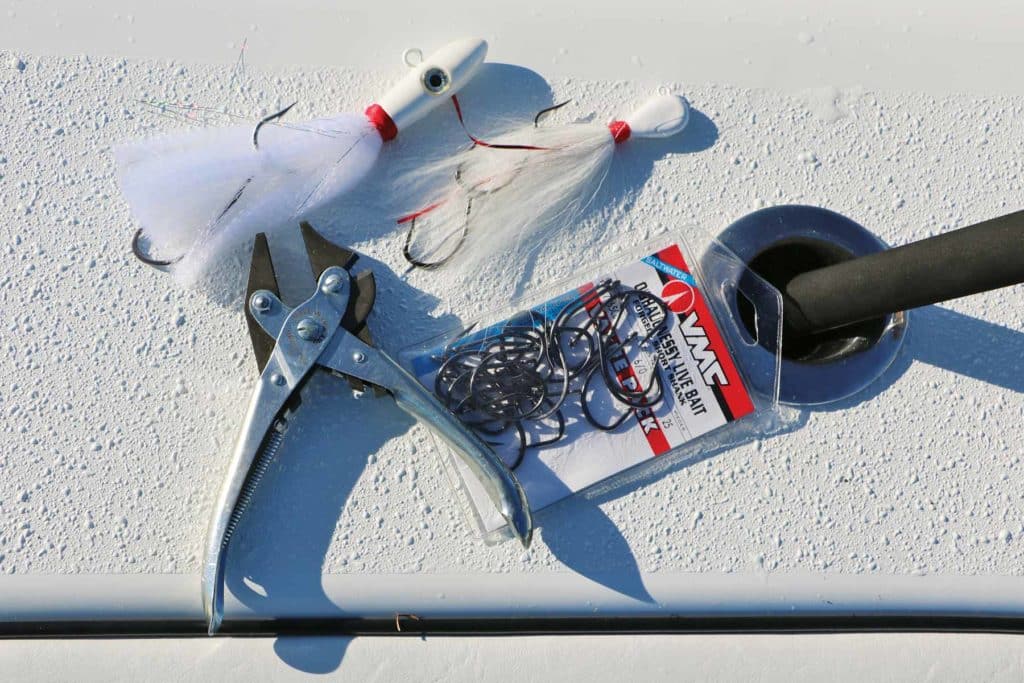
Check your ballyhoo next to the boat before casting: If hooked properly, the ballyhoo should swim naturally. (Some anglers bend it upward to break the backbone and add to its flexibility in the water.)
R&R — as well as Halco Tackle — makes lead-head jigs with a treble hook on a short wire trailer attached to the jig. This can be quite effective, though it might reduce the ‘hoo’s swimming action, and limit you to somewhat-heavier jig heads.
Finally, you’ll need plenty of ballyhoo (at times, besides the bite-offs, triggerfish can maul a lot of baits). Some anglers catch their own, but many find they get a lot more fishing time by simply buying fresh-frozen ballyhoo for use when/as needed. Baitmasters of South Florida sells sizes ranging from 6-inch peewees to 10.5-plus-inch jumbos, and ships baits all over the United States.
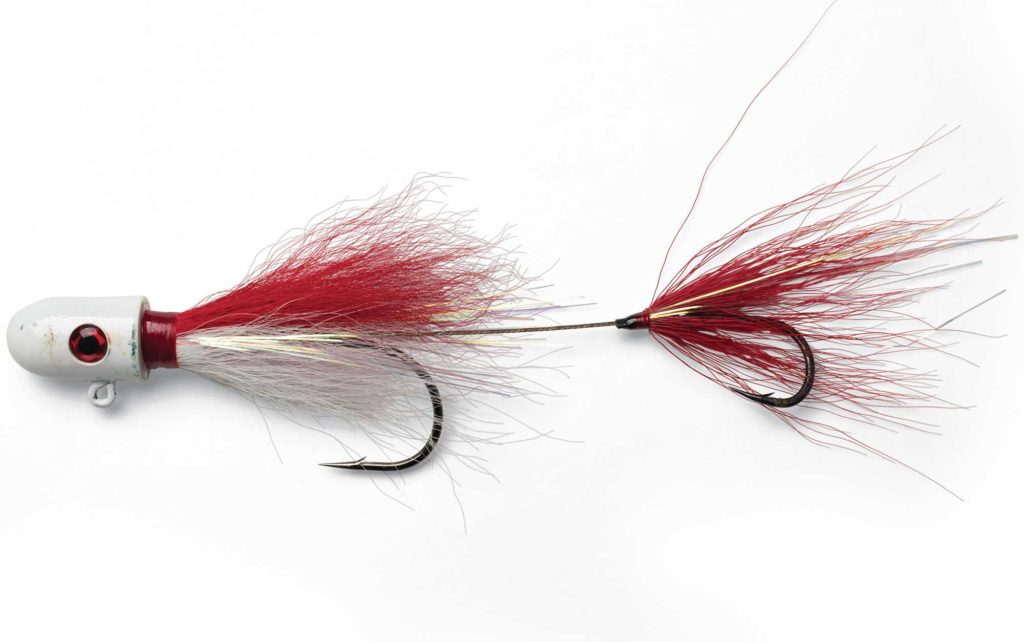
Tips on Techniques
Since I’m recommending fishing ballyhoo on pretty light jig heads, I need to stress again the importance of casting into the drift (or, if anchored, up-current). If you simply let a light jig-and-‘hoo over the side in a moderate current, it will keep drifting away from the boat and likely never reach the bottom. Casting far into up-drift gives the rig ample time to sink before it is underneath the boat.
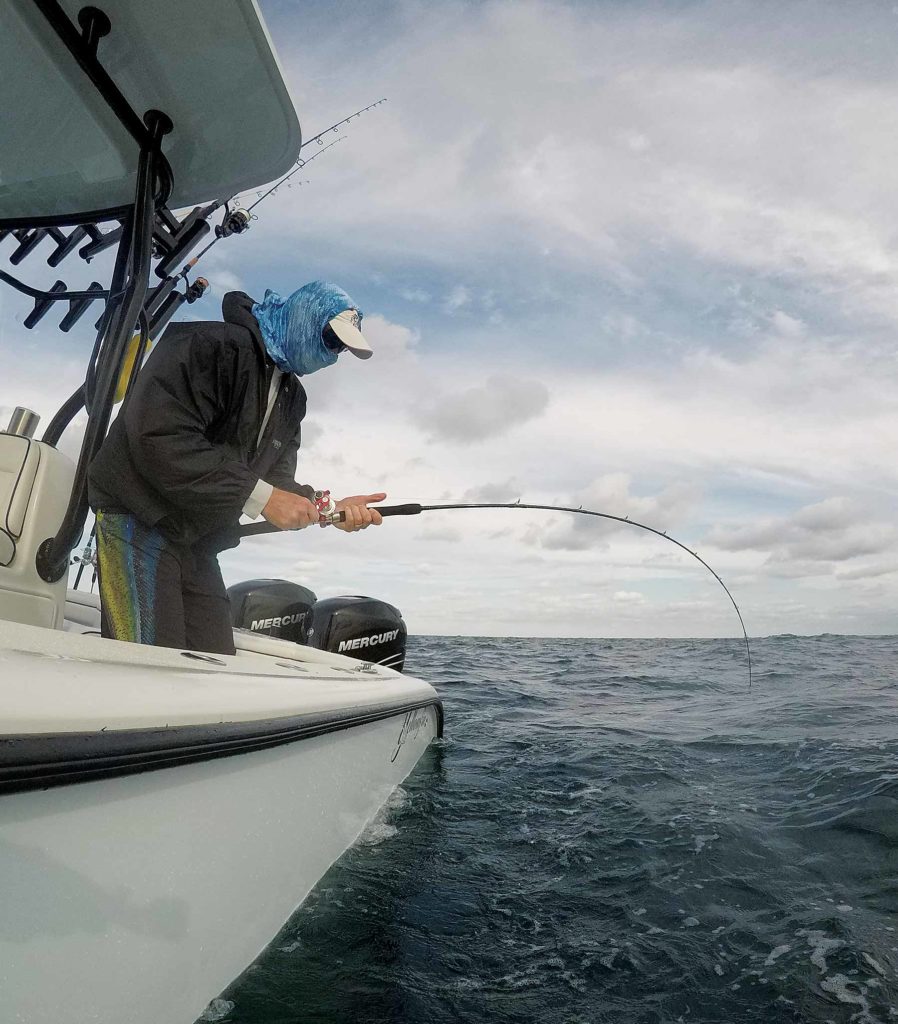
But be ready at all times. One of the exciting aspects of this technique is knowing that you can get slammed at any second; then, a quick hook-set is essential. Similarly, when you begin working the bait, remember, you’re not working a speed jig. I find that longer sweeps, with a pause in between, seem to get the best results. (But, again, be ready: Often a big fish will wallop the bait at the top of your arc, challenging you to crank down fast and hard enough to set the hooks.)
Read Next: How to Fish Bucktails Jigs to Catch More Fish
Long casts are facilitated with full spools on quality spinning reels. By going with 20- or 30-pound braid (versus, say, 80-pound), even a light jig can be tossed out some distance. Anglers skilled at casting small conventionals can do just as well.
I’m not suggesting this is the ultimate, can’t-miss method. But I do maintain that fishing bucktails-and-ballyhoo properly can offer yet another way to fish reefs up to moderate depths and catch just about anything that swims. And when something slams that bait in what seems like an effort to remove your arms from your torso, you’ll be a believer.








